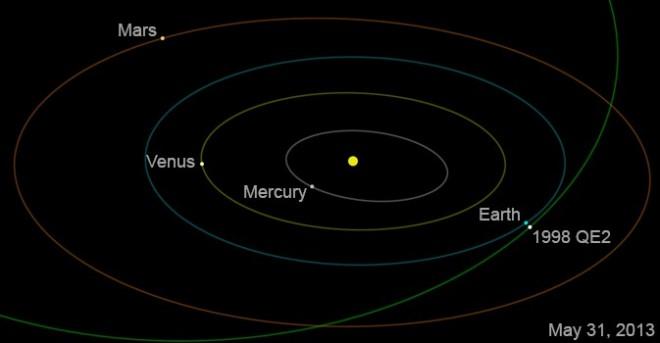
NASA's Jet Propulsion Laboratory has confirmed that a massive asteroid nine times larger than a cruise ship is set to zip pass the planet in May.
The asteroid named 1998 QE2 will be at a 'distance of 3.6 million miles (5.8 million kilometres), or about 15 times the distance between Earth and the moon" on 31 May.
Speaking of the galactic phenomenon, Lance Benner, of Goldstone radar observations from NASA's Jet Propulsion Laboratory said, "Whenever an asteroid approaches this closely, it provides an important scientific opportunity to study it in detail to understand its size, shape, rotation, surface features, and what they can tell us about its origin. We will also use new radar measurements of the asteroid's distance and velocity to improve our calculation of its orbit and compute its motion farther into the future than we could otherwise."
The humongous asteroid is "believed to be about 1.7 miles (2.7 kilometers) or nine Queen Elizabeth 2 ship-lengths in size."
The asteroid will be observed in a radar image via Nasa's two powerful telescopes, one is the 230-foot-wide (70 metre) Deep Space Network antenna at Goldstone and the other from Arecibo Observatory in Puerto Rico.
An excited Benner revealed, "It is tremendously exciting to see detailed images of this asteroid for the first time," adding, "With radar we can transform an object from a point of light into a small world with its own unique set of characteristics. In a real sense, radar imaging of near-Earth asteroids is a fundamental form of exploring a whole class of solar system objects."
However, scientists have ruled out any possibility of the asteroid's collision with Earth since it will be at a safer distance.
Earth has recent experienced several close encounters with asteroids, the most significant being the asteroid which struck Chelyabinsk, Russia on 15 February killing around 1000 people.





!['Had denied Housefull franchise as they wanted me to wear a bikini': Tia Bajpai on turning down bold scripts [Exclusive]](https://data1.ibtimes.co.in/en/full/806605/had-denied-housefull-franchise-they-wanted-me-wear-bikini-tia-bajpai-turning-down-bold.png?w=220&h=138)



